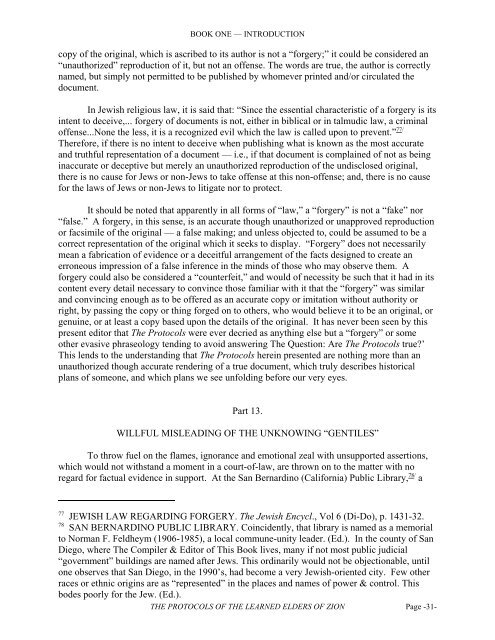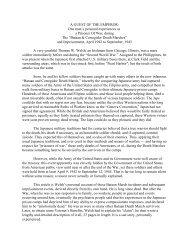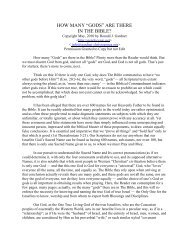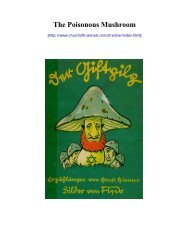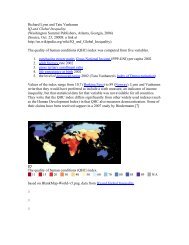The Protocols of the Learned Elders of Zion -- Book - A Gentle Cynic
The Protocols of the Learned Elders of Zion -- Book - A Gentle Cynic
The Protocols of the Learned Elders of Zion -- Book - A Gentle Cynic
You also want an ePaper? Increase the reach of your titles
YUMPU automatically turns print PDFs into web optimized ePapers that Google loves.
BOOK ONE — INTRODUCTION<br />
copy <strong>of</strong> <strong>the</strong> original, which is ascribed to its author is not a “forgery;” it could be considered an<br />
“unauthorized” reproduction <strong>of</strong> it, but not an <strong>of</strong>fense. <strong>The</strong> words are true, <strong>the</strong> author is correctly<br />
named, but simply not permitted to be published by whomever printed and/or circulated <strong>the</strong><br />
document.<br />
In Jewish religious law, it is said that: “Since <strong>the</strong> essential characteristic <strong>of</strong> a forgery is its<br />
intent to deceive,... forgery <strong>of</strong> documents is not, ei<strong>the</strong>r in biblical or in talmudic law, a criminal<br />
<strong>of</strong>fense...None <strong>the</strong> less, it is a recognized evil which <strong>the</strong> law is called upon to prevent.” 77/<br />
<strong>The</strong>refore, if <strong>the</strong>re is no intent to deceive when publishing what is known as <strong>the</strong> most accurate<br />
and truthful representation <strong>of</strong> a document — i.e., if that document is complained <strong>of</strong> not as being<br />
inaccurate or deceptive but merely an unauthorized reproduction <strong>of</strong> <strong>the</strong> undisclosed original,<br />
<strong>the</strong>re is no cause for Jews or non-Jews to take <strong>of</strong>fense at this non-<strong>of</strong>fense; and, <strong>the</strong>re is no cause<br />
for <strong>the</strong> laws <strong>of</strong> Jews or non-Jews to litigate nor to protect.<br />
It should be noted that apparently in all forms <strong>of</strong> “law,” a “forgery” is not a “fake” nor<br />
“false.” A forgery, in this sense, is an accurate though unauthorized or unapproved reproduction<br />
or facsimile <strong>of</strong> <strong>the</strong> original — a false making; and unless objected to, could be assumed to be a<br />
correct representation <strong>of</strong> <strong>the</strong> original which it seeks to display. “Forgery” does not necessarily<br />
mean a fabrication <strong>of</strong> evidence or a deceitful arrangement <strong>of</strong> <strong>the</strong> facts designed to create an<br />
erroneous impression <strong>of</strong> a false inference in <strong>the</strong> minds <strong>of</strong> those who may observe <strong>the</strong>m. A<br />
forgery could also be considered a “counterfeit,” and would <strong>of</strong> necessity be such that it had in its<br />
content every detail necessary to convince those familiar with it that <strong>the</strong> “forgery” was similar<br />
and convincing enough as to be <strong>of</strong>fered as an accurate copy or imitation without authority or<br />
right, by passing <strong>the</strong> copy or thing forged on to o<strong>the</strong>rs, who would believe it to be an original, or<br />
genuine, or at least a copy based upon <strong>the</strong> details <strong>of</strong> <strong>the</strong> original. It has never been seen by this<br />
present editor that <strong>The</strong> <strong>Protocols</strong> were ever decried as anything else but a “forgery” or some<br />
o<strong>the</strong>r evasive phraseology tending to avoid answering <strong>The</strong> Question: Are <strong>The</strong> <strong>Protocols</strong> true?’<br />
This lends to <strong>the</strong> understanding that <strong>The</strong> <strong>Protocols</strong> herein presented are nothing more than an<br />
unauthorized though accurate rendering <strong>of</strong> a true document, which truly describes historical<br />
plans <strong>of</strong> someone, and which plans we see unfolding before our very eyes.<br />
Part 13.<br />
WILLFUL MISLEADING OF THE UNKNOWING “GENTILES”<br />
To throw fuel on <strong>the</strong> flames, ignorance and emotional zeal with unsupported assertions,<br />
which would not withstand a moment in a court-<strong>of</strong>-law, are thrown on to <strong>the</strong> matter with no<br />
regard for factual evidence in support. At <strong>the</strong> San Bernardino (California) Public Library, 78/ a<br />
77 JEWISH LAW REGARDING FORGERY. <strong>The</strong> Jewish Encycl., Vol 6 (Di-Do), p. 1431-32.<br />
78 SAN BERNARDINO PUBLIC LIBRARY. Coincidently, that library is named as a memorial<br />
to Norman F. Feldheym (1906-1985), a local commune-unity leader. (Ed.). In <strong>the</strong> county <strong>of</strong> San<br />
Diego, where <strong>The</strong> Compiler & Editor <strong>of</strong> This <strong>Book</strong> lives, many if not most public judicial<br />
“government” buildings are named after Jews. This ordinarily would not be objectionable, until<br />
one observes that San Diego, in <strong>the</strong> 1990’s, had become a very Jewish-oriented city. Few o<strong>the</strong>r<br />
races or ethnic origins are as “represented” in <strong>the</strong> places and names <strong>of</strong> power & control. This<br />
bodes poorly for <strong>the</strong> Jew. (Ed.).<br />
THE PROTOCOLS OF THE LEARNED ELDERS OF ZION Page -31


